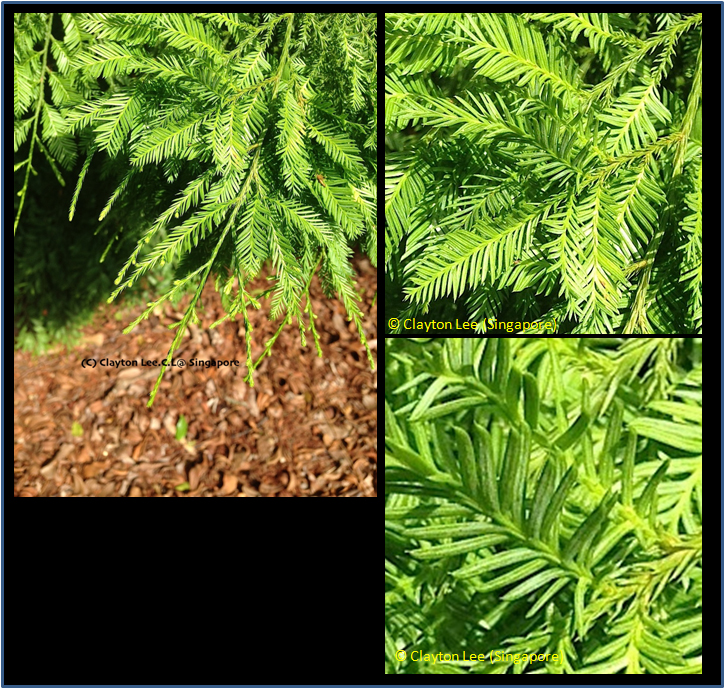Dacrycarpus imbricatus (Blume) de Laub., J. Arnold Arbor. 50: 317 (1969)
Species name meaning 'tiled, in the meaning of overlapping', referring to the leaves.Synonyms
Bracteocarpus imbricatus (Blume) A.V.Bobrov & Melikyan
Bracteocarpus kawaii (Hayata) A.V.Bobrov & Melikyan
Dacrycarpus imbricatus var. imbricatus
Dacrycarpus imbricatus var. patulus de Laub.
Dacrycarpus kawaii (Hayata) Gaussen [Invalid]
Nageia cupressina (R.Br. ex Benn.) F.Muell.
Podocarpus cupressinus R.Br. ex Benn.
Podocarpus horsfieldii R.Br. ex Wall. [Invalid]
Podocarpus imbricatus Blume
Podocarpus javanicus (Burm.f.) Merr.
Podocarpus kawaii Hayata
Thuja javanica Burm.f.
Diagnostics
Conifer with resinous exudates (reddish-orange, aromatic). Branches spreading and the lower
branches drooping.
Fruiting branches slightly quadrangular.Leaves heteromorphic: young trees linear and
needle-like, older
and fertile branches scale shaped. Seeds ovoid with a red aril (epimatia). [from BIOTIK]
Description
Trees up to 50 m tall and 50-70(-200) cm dbh, with straight clear bole of up to 20 m and often
a dome-shaped crown. Branches abundant, spreading, the lower ones often pendulous. Fruiting
branches slightly quadrangular. Bark red-brown and rugose. Inner bark orange, with brownish
resin. Leaves of primary shoots imbricate; leaves of juvenile foliage shoots distichous, nearly
linear, (6-)10-17 mm long by 1.2-2.2 mm wide at the centre of a shoot, gradually losing the
distichous habit as the tree matures, but shoots with more or less bilaterally flattened leaves
distinctly longer in the middle of the shoot almost always present on even the oldest trees.
Terminal shoots on young plants often elongated whip-like up to 20 cm. Leaves on older trees
eventually becoming mostly scale-like, imbricate, distinctly keeled on the dorsal side, long-
triangular, 1-3 by 0.4-0.6 mm. Involucral leaves becoming spreading, acicular, 2.5-4 mm long,
rarely to 5 mm. Male cone axillary, 1 cm long. Female cones solitary or grouped in 2 at the tip
of twigs, but only one fertile, ripe receptacle red. Seed ovoid, 0.5-0.6 cm long, glossy, red
when mature. [from The Gymnosperm Database]
Ecology
Found in closed evergreen forest, and open degraded Fagaceous and Dipterocarp forests from 500
to 3000 m altitude. Usually in small groups of 3-5 trees. Mostly scattered and common in primary
and secondary rain-forest, not rarely as an emergent, and co-dominant in West Java with
Podocarpus neriifolius and Allingia noronhae, on the south slope of
Mt Tjeremai volcano characterizing the zone between 2400-2700 m without other co-dominants, a
situation not yet explained, in Timor found under more or less seasonal conditions
in isolated specimens laden with Usnea in grassland after deforestation, mostly between
1000-2500 m, but in Lombok reported as low as 200 m and in Sulawesi ascending to 3000 m. Probably
exterminated at lower elevations in Java by deforestation. Sometimes the stem of
full-grown trees produces sprouts at the base. In N. Sumatra pure stands on exposed
mossy mountain peaks, on blangs and steep slopes, between 2000 and 3420 m.
Distribution
From Southern China and Burma all the way to New Guinea and the West Pacific Islands.
Uses
The wood has a variety of uses: resin harvesting, construction, furniture, firewood. In some areas
cultivated as ornamental tree.
Local names
Bali: tarupanda.
Borneo: menjilu, Dusun lang., Kp. Tindai, Sabah, tampilas, Sensurun, Sabah, Dusun lang.
Flores: oh-ru, Ruteng.
Java: djamudju, kihadji, kipuiri, tjemoro (tukung), Tjidadap, S; kadju pakis, tjemara bin¨¨h, Md.
Lombok: majangmekar.
Malaya: ru hukil, Kedah.
Sulawesi (Bonthain): kayu angin, k. parang, siozi, Mt Wuka Tampai. Palu.
Sumatra: ambun, Solok, W. Coast, halanidju, Kerintji, heru, Karo Lands, ki merak, marak, Bencoolen,
damanik, Simelungun, Sampinur bunga, Karo-Toba, lalas, Kroe, Bencoolen.
Sumba: kayu awama, Lairondja, kadju uamang.
Timor: haae tuni, W. Timor, Nenas, ai-caqueu fuie, E. Timor, Tetun lang.
